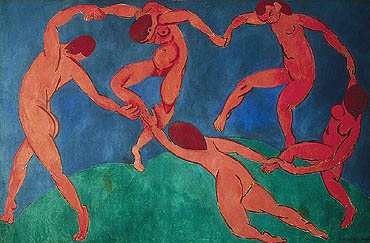The Dance (second version)
- The Dance (second version)
Infobox Painting|

backcolor=#FBF5DF
painting_alignment=right
image_size=300px
title=The Dance (second version)
artist=Henri Matisse
year=1910
type=Oil on canvas
height=260
width=391
height_inch=
width_inch=
city=St. Petersburg
museum=The Hermitage
"The Dance (second version)" ("La Danse"), is a painting from 1910 by Henri Matisse.
History
"The Dance (second version)," is a large decorative panel, painted with a companion piece, "La Musique", specifically for the Moscow mansion of the Russian businessman and art collector Sergei Shchukin, with whom Matisse had a long association.
The painting shows five dancing figures, painted in a strong red, set against a very simplified green landscape and deep blue sky. It reflects Matisse's incipient fascination with primitive art, and uses a classic Fauvist colour palette: the intense warm colors against the cool blue-green background and the rhythmical succession of dancing nudes convey the feelings of emotional liberation and hedonism. The painting is often associated with the "Dance of the Young Girls" from Igor Stravinsky's famous musical work "The Rite of Spring".
"The Dance (second version)" is commonly recognized as "a key point of (Matisse's) career and in the development of modern painting". [Russell T. Clement. "Four French Symbolists". Greenwood Press, 1996. Page 114.] It is now in the Hermitage Museum in St. Petersburg.
"The Dance" (preliminary version)
In March 1909 Matisse painted a preliminary version of this work, known as "Dance", which is now at the Museum of Modern Art in New York. [John Elderfield. "Henri Matisse: A Retrospective". The Museum of Modern Art, New York, 1992. Page 181.] It uses paler colors and less detail. The painting was highly regarded by the artist who once called it "the overpowering climax of luminosity"; it is also featured in the background of Matisse's "La Danse with Nasturtiums" (1912).
Notes and references
External links
* [http://painting.about.com/od/arthistorytrivia/ig/Gallery-of-Famous-Paintings/Getty-MatisseDancers.htm Two versions of "The Dance"]
Wikimedia Foundation.
2010.
Look at other dictionaries:
The Burger King — as seen in Burger King s Wake Up with the King commercial Agency: Crispin Porter + Bogusky Client: Burger King … Wikipedia
After the Dance — This article is about the 1976 song. For the Terence Rattigan play see After the Dance After the Dance is a slow jam recorded by singer Marvin Gaye and released as the second single off Gaye s hit album, I Want You . Though it received modest… … Wikipedia
The Tide Is High — Single by The Paragons A side Only a Smile Released 1967 Genre Rocksteady Length … Wikipedia
The Wizard of Oz (1939 film) — The Wizard of Oz Theatrical release poster Directed by Victor Fleming Uncredited: Norman Taurog Richard Thorpe … Wikipedia
Dance with the Wolves — Single by Ruslana from the album Wild Dances Released January 2005 (Ukraine) Format … Wikipedia
The Beatles bootleg recordings — are performances by The Beatles that have attained some level of public circulation without being available as a legal release. The term most often refers to audio recordings, but also includes video performances. From the earliest Beatles… … Wikipedia
The Turbans — were an African American doo wop group, who were formed in Philadelphia in 1953. The original members were: Al Banks (lead tenor), Matthew Platt (second tenor), Charlie Williams (baritone), and Andrew Chet Jones (bass). They came from Downtown… … Wikipedia
Dance Dance Revolution 2ndMix — Artwork for the PlayStation port of Dance Dance Revolution 2ndMix, titled 2ndReMix. Mentioning the ability to share data between the PlayStation games and properly equipped arcade machines … Wikipedia
The Beatles' influence on popular culture — The Beatles influence on rock music and popular culture was and remains immense. Their commercial success started an almost immediate wave of changes including a shift from US global dominance of rock and roll to UK acts, from soloists to groups … Wikipedia
The Jungle Book — (1894) is a collection of stories written by Rudyard Kipling. Kipling was born in India and spent the first six years of his childhood there. After about ten years in England, he went back to India and worked there for about six and half years.… … Wikipedia

